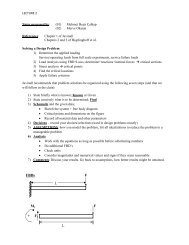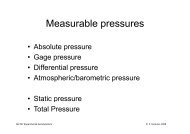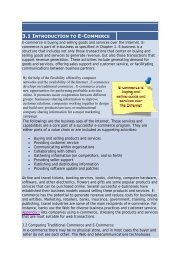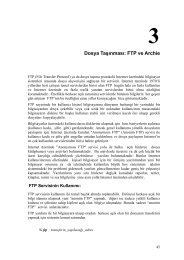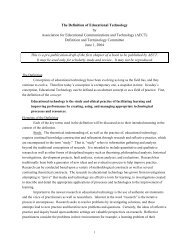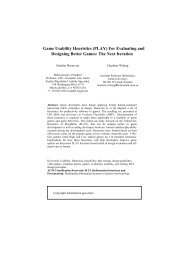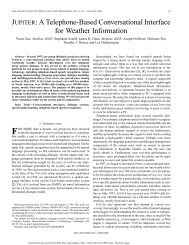2.1 INTRODUCTİON TO E-MARKETTİNG
2.1 INTRODUCTİON TO E-MARKETTİNG
2.1 INTRODUCTİON TO E-MARKETTİNG
Create successful ePaper yourself
Turn your PDF publications into a flip-book with our unique Google optimized e-Paper software.
<strong>2.1</strong> <strong>INTRODUCTİON</strong> <strong>TO</strong> E-<strong>MARKETTİNG</strong><br />
The Internet and the World Wide Web provide marketers with new tools and<br />
added convenience that can increase the success of their marketing efforts.<br />
The Web offers several technologies and applications that could enhance<br />
customer service, marketing and advertising efforts with a reasonable cost.<br />
The Web could improve customer service by sending e-mail for order<br />
confirmation, product announcements, and order tracking. The Web provides<br />
customer service through corporate web sites, integrated call centers, online<br />
help desks, and online customer service.<br />
In recent years, customers have used business web sites for many different<br />
applications: downloading forms, software patches, printer drivers, minor<br />
upgrades to an existing software, and receiving on time answers to frequently<br />
asked questions. All of these features have improved customer service and<br />
lowered costs for both the business and its customers.<br />
The Internet and the World Wide Web provide marketers with new tools and<br />
added convenience that can increase the success of their marketing efforts.<br />
The Web offers several technologies and applications that could enhance<br />
customer service, marketing and advertising efforts with a reasonable cost.<br />
The Web could improve customer service by sending e-mail for order<br />
confirmation, product announcements, and order tracking. The Web provides<br />
customer service through corporate web sites, integrated call centers, online<br />
help desks, and online customer service.<br />
In recent years, customers have used business web<br />
sites for many different applications: downloading<br />
forms, software patches, printer drivers, minor<br />
upgrades to an existing software, and receiving on<br />
time answers to frequently asked questions. All of<br />
these features have improved customer service and<br />
lowered costs for both the business and its customers.<br />
Page-loading speed has a direct association with the<br />
number of visitors viewing the page; therefore,<br />
complex graphics and large tables should be avoided<br />
at least in the initial page.
If you use well, actually Web is an effective<br />
marketing instrument. Different advertising and<br />
marketing tools on the Web include banner<br />
advertisements, discussion lists, e-mail and<br />
registering e-mail, links on other web sites,<br />
newsgroups, online classified advertisements,<br />
message boards and special interest shopping<br />
centers, display screens, spot leasing, intelligent<br />
agents.<br />
The Web helps in online customer research.<br />
Customers by using online catalogs are able to<br />
conduct product searches and compare and<br />
contrast different features of different products.<br />
Legal data about customers can also be<br />
collected directly or indirectly through cookies,<br />
intelligent agents and online questionnaires.<br />
Online customer data can be collected very fast<br />
and with minimum cost. Intelligent agents are<br />
rule based software that can be used effectively<br />
in the e-commerce environment. Intelligent<br />
agents and shopping bots are increasingly used<br />
in the e—commerce world to assist customers in<br />
finding the cheapest possible prices for<br />
customer. They are also a marketing tool for<br />
collecting relevant information regarding<br />
customers’ purchasing habits and the sites they<br />
usually visit.<br />
To better understand Web marketing and advertising some commonly used<br />
terminology can found in Appendix II at the end of this chapter.<br />
2.2 THE WEB AS A MARKETİNG <strong>TO</strong>OL<br />
The Web puts large and small organizations on<br />
the same foothold. Regardless of size or<br />
financial strengths, any business can sell goods<br />
and services through the Web. Users have<br />
already divided themselves into interest or<br />
newsgroups entire with e-mail addresses.<br />
Because of the democratic atmosphere<br />
consumers are on the plus side of the power<br />
balance. They can respond individually to a<br />
marketing attempt or they can spread the word<br />
to their associates. If they support, everything is<br />
fine; however, if they dislike, consumers have<br />
the power in this medium to cause chaos with an<br />
ill-fated marketing attempt.
with messages not to do it again. Marketers, therefore, should only post brief<br />
messages to related newsgroups that are relevant to a company’s campaign.<br />
Suitable newsgroups should be identified before attempting contact. Martin<br />
Nisenholtz has suggested the following six guidelines for Internet advertising<br />
[4].<br />
• Advertise only in selected newsgroups.<br />
• Never send disturbing messages.<br />
• Use full agreement to conduct direct selling or<br />
promotions.<br />
• Obtain the consumer’s permission when carrying<br />
out research.<br />
• Take permission of the user prior to selling<br />
consumer data.<br />
• Never use Internet communications to hide real<br />
activities of the business.<br />
Businesses successfully use passive advertising by setting up bulletin boards. This requires minim<br />
cover the hardware and software costs. An alternative would be to publish advertisements throu<br />
service provider (ISP) such as SuperOnline or E-Kolay, a directory such as Yahoo!, or a search eng<br />
Google. However, if you plan to deal with e-marketing, a home page is the medium perhaps best<br />
advertising on the World Wide Web.<br />
Many companies have established home pages for business advertising. Here, the advantage is th<br />
messages can be individually customized for each customer. Companies are generally making pro<br />
information, press releases, e-mail index, and financial information available via the Web. Some<br />
now start to include a URL address on their cans or bottles or packets that a customer can access<br />
information on the product, such as information related to the ingredients, nutritional facts, and<br />
Newsgroups are other advertising areas on the Web. For example, if a business wanted to advert<br />
(hey could post their advertisement in newsgroups that are interested in cats.<br />
Business use of the Web is still very much in the introductory stage, thus,<br />
small advertisers are producing the majority of online advertising. The<br />
present situation can be compared to the early days of cable TV. On the<br />
other hand, the introduction of cable modems and Asymmetric Digital<br />
Subscriber Line (ADSL) - form of DSL- will result in increased popularity and<br />
business usage of the Web.<br />
2.3 MARKETİNG <strong>TO</strong>OL: THE WEB<br />
Any organization using the Web can advertise all over the world and sell 7days<br />
a week, 24-hours a day. The Web serves is a strong marketing tool for all<br />
types of organizations regardless of their size and the types of products and<br />
services that they sell (Figure <strong>2.1</strong>). [3]
Collecting marketing data through the Web could improve the marketing<br />
efforts of any organization. An organization using these data will be able to<br />
customize a particular product or service to the specific needs and<br />
requirements of a potential buyer. Marketing data can be collected through<br />
various tools available on the Web with reasonable cost. E-mail, online<br />
forms, online questionnaires, discussion lists, newsgroups, cookies, and<br />
intelligent agents are among the popular tools that can be used for this<br />
purpose. The businesses can utilize these data and do different types of<br />
analyses including determining the status of the subscriber (if the taken data<br />
is online), the accuracy of the data and so forth.<br />
Advertising traditional products through the Web to sell has become<br />
popular in recent years. Online stores are able to offer a variety of choices<br />
and in many cases lower prices. With the introduction of e-wallets, e-cash,<br />
and other electronic payment systems (EPSs), customers are able to pay for<br />
these products and services with improved security and convenience. This is<br />
basically transferring the old trade model to the Web and taking advantage of<br />
all the technologies and applications that the Web offers.<br />
Advertising digital products to sell is a new way that businesses can<br />
generate revenue with reasonable expenses. Downloading a piece of<br />
software, a song, a magazine article, or a movie are some examples. These<br />
applications are expected to increase dramatically, with the increased<br />
popularity of cable modems, ADSL that can allow higher bandwidth, and<br />
tighter security measures.<br />
Online marketing is becoming popular applications of Web marketing.<br />
Marketers are able le reach a wide geographic base and collect marketing<br />
data with no or reasonable cost. These marketing data can be used for testing<br />
various experiments, such as the attractiveness of an advertising campaign or<br />
the strengths and weaknesses of a marketing medium, with moderate costs.
Supporting marketing 4P can be done by the help of the Web. Marketing is<br />
related with product, price, promotion, and place (4P). The data related to<br />
the four factors of marketing can be collected very rapidly with moderate<br />
cost. The Web provides unparalleled support for these 4P.<br />
• The product factor is concerned with the type of products and<br />
services that an e-business plans to sell. These products and services<br />
could be new brand or a development over existing products and<br />
services. The improvements might be price, features and/or usability.<br />
• The price factor is concerned with the most suitable price for the<br />
product or service. Overpricing and under pricing are both<br />
undesirable. Collecting online data and analyzing a competitor's<br />
offerings could help the e-business to establish a reasonable price for<br />
its products or services.<br />
• The promotion factor aims to inform, convince, and remind<br />
customers regarding new products and services and encourage repeat<br />
sales. Web technology could be able to do this with reasonable costs.<br />
• The place factor is concerned with the mechanisms that the ebusiness<br />
uses to get products and services to customer. In many cases,<br />
the Web provides virtual storefronts for some customers that<br />
otherwise could not have been able to do any transaction with a<br />
particular e-business. Customers in remote or rural areas or customers<br />
who are immobile and unable to shop in traditional stores are some<br />
examples.<br />
Appendix I gives some Web resources for conducting successful Web<br />
marketing and advertising.<br />
Customization can be provided by the Web with moderate cost. For<br />
example, Amazon.com displays specific recommendations based on the<br />
customer’s previous purchases. These kinds of services are very expensive in<br />
traditional marketing. The e-business can move from providing general<br />
products or services to providing products or services customized to a<br />
customer’s needs, tastes and preferences by the help of the Web. The<br />
following two technologies are commonly used to provide<br />
customization/personalization:<br />
• Push technology: The customer is automatically offered with<br />
information by being sent to the right place. The Web can send<br />
relevant information to the customer workstation.<br />
• Pull technology: The customer must express a need in order to receive<br />
information. The Web is able to implement this strategy very<br />
effectively with moderate cost.<br />
Virtual storefronts -the Web servers- help the businesses to attract the<br />
customers. This virtual site of a business can effectively express the unique<br />
offerings of an e-commerce site to potential visitors and can be easily<br />
modified to reflect the new offerings. Customers can browse through the site<br />
at their own speed to find special products and services. Figure 2.2, Figure
2.3 and Figure 2.4 demonstrate the opening page of biletix.com,<br />
hepsiburada.com and ebay.com , respectively. Each storefront has diverse<br />
goals and purposes, and each one express a different message to its<br />
customers. Browse through these sites to see how effectively they are using<br />
the Web for diverse business purposes.<br />
Matching products and services to customers' needs is a powerful feature of<br />
Web marketing. The internal search engines available on many of ecommerce<br />
sites allow the customer to search for a particular product and<br />
service. For Example, sites such as Amazon.com display recommendations<br />
onto the site based on your earlier purchases.<br />
Contact with customers is allowed by the Web to the e-businesses. Using email<br />
and the company web site, customers can freely state their opinions<br />
regarding the products and services sold by a potential e-commerce site, as<br />
the e-business and its customers are in close contact. In other words, the<br />
Web offers an open forum for customers.<br />
2.4 SUPPORTİNG A WEB SİTE<br />
An e-business first must bring customers and visitors to its Web site to sell its<br />
products and services. The Web site can be powerfully marketed using the<br />
followings:<br />
• The Web site can be registered with all (at least most popular) search<br />
engines and directories. The site can be listed in popular search
engines and directories such as Google, Yahoo or in industry specific<br />
sites. When the site is registered, the location of the keyword in the<br />
site (whether it's in the body or in the heading) and the frequency of<br />
the word's use will have direct effect on the ranking of a page. A<br />
typical surfer usually looks at the top 10 to 20 listings after conducting<br />
a Web search. The Web site must make sure that the search engine<br />
lists the site among the top 10; otherwise, the chances of being seen<br />
by many surfers are low.<br />
• The Web site can be promoted by using banner and other Web<br />
advertising methods on popular search engines, directories, and Web<br />
portals.<br />
• The Web domain name can be written on all printed and written<br />
forms, letterhead, envelopes, business cards, company cars, and<br />
equipment, and so forth.<br />
• The Web site can be advertised to existing customers. Present<br />
customers will be the first to be glad about the added handiness of<br />
online business and pass the word to their friends and families.<br />
• The Web site can be promoted by joining online discussion groups to<br />
people already interested in the company's offerings.<br />
• URL links can be exchanged with other web sites that offer companion<br />
products or services.<br />
• The business can participate in free ad banner exchanges. Your<br />
company can agree to carry banner advertising in exchange for other<br />
sites carrying your company ad banners.<br />
• E-mail lists can be used to send out notices or newsletters on the<br />
company's products and services.<br />
• The company can offer bargain, competitions, quizzes, coupons.<br />
• The results of popular sport matches and lotteries can be displayed.<br />
Last items provide rich content for the Web site and encourage visitors to<br />
come back to the site.<br />
2.5 WEB MARKETİNG <strong>TO</strong>OLS<br />
Any An e-commerce site may use a combination of traditional and Web<br />
marketing tools to promote its products/services. Obviously marketing<br />
methods that have the potential to reach the highest number of prospective<br />
customers are more expensive.<br />
Each technique has advantages and disadvantages and may be appropriate for<br />
a specific type of business.<br />
Traditional Marketing Tools: Magazines, newspapers, posters, press<br />
releases, radio, and television commercials, and word of month are the<br />
traditional media that can be used to promote an e-marketing/commerce<br />
site. For instance, a television commercial can be very effective during<br />
popular shows and programs; however, they are extremely expensive and<br />
usually beyond the budget of many e-marketing/commerce sites. Newspapers<br />
and magazines could be effective especially if the e- marketing/commerce<br />
site has a traditional business in place already.
E-Mail: E-mail is generally used for shipment<br />
confirmations, order confirmations, common<br />
communication with customers and product<br />
announcements. Capturing customer information<br />
could be necessary for repeat sales. Therefore,<br />
successful e-businesses register the customer's email<br />
and other relevant information using online<br />
forms. E-mail could be quite effective for repeat<br />
sales, reminding the customer for the next<br />
purchase or for the next visit. As an example,<br />
consider an e-business that sells flowers. An<br />
automatic e-mail system can alert a customer that<br />
a particular birthday is coming up. With a mouse<br />
click the customer can order flowers. However,<br />
with all these advantages, e-mail must be used<br />
with caution. Customers should not be attacked<br />
with needless e-mails. The sale and the customer<br />
can be lost, if a customer gets irritated.<br />
Discussion Lists: An e-business can subscribe to one or several discussions<br />
lists and post relevant information regarding its products/services. Discussion<br />
lists provide a strong advertising medium. However, the organizations must<br />
first carry out careful analysis and find the most suitable list that might be<br />
interested in the offerings of the e-marketing/commerce site. Appendix III<br />
lists several resources to find suitable discussion list resources.<br />
Newsgroups: A newsgroup allows a discussion<br />
about a particular subject. Newsgroups are<br />
organized into subject hierarchies. Posting on<br />
these newsgroups is free. A newsgroup can serve<br />
as a powerful advertising medium. Before joining<br />
and posting to these newsgroups, the e-business<br />
must do some analysis and read the frequently<br />
asked questions of a particular newsgroup. Direct<br />
advertising should be avoided as it may not be<br />
attractive to the participants of a newsgroup. To<br />
use newsgroups as an advertising medium, after a<br />
short message you may post the URL of the ecommerce<br />
site.<br />
Banner Advertisements: A banner advertisement -an advertising image- is<br />
usually a graphic image that displays the name or identity of a site. A banner<br />
can be clickable, which will transfer surfers to another site, or just static,<br />
which shows some relevant information about a site, product/service offered<br />
by the e-commerce site. A banner ad is much less costly than TV ads. Where<br />
to put a banner ad is also very important. For instance, if the site is selling<br />
insurance, then the banner ad should be placed in an online car dealer site or<br />
in a bank site or a mortgage company site. The banners in Yahoo sites on
theme. (Figure 2.5 and Figure 2.6) As well, banners should be placed on sites<br />
that magnetize large traffic. However, the cost of banner ads varies with the<br />
popularity and the traffic that the sponsoring site carries.<br />
Message Boards and Special Interest Malls: A product and or service can<br />
be listed in several of message boards and special interest malls throughout<br />
the Web. Before you list a product or service a complete search must be<br />
conducted in order to find the most suitable message board for the intended<br />
product or service.<br />
Links on Other Web Sites: An e-business could create a partnership with<br />
other e-businesses for link exchange agreements. Your site creates a link to<br />
another site, and that site creates a link to your site.<br />
Initial Web Site Page: An initial web site page<br />
which can display the e-business's corporate image<br />
and brand in some cases captures the surfer's<br />
attention for a short period. It displays a message<br />
to the surfer indicating the requirement for<br />
viewing the page, such as the browser type and<br />
the specific software. This advertising medium<br />
that may use multimedia effects could be very<br />
effective for attracting visitors to an e-business<br />
site.
Push Technology: Push technology means relevant<br />
information is pushed to the user based on his or<br />
her prior inquiries, interests, or specifications.<br />
The Web works based on pull technology, meaning<br />
the user searches the Web to find (to pull)<br />
information. However, push technology is more<br />
suitable for the marketing of certain<br />
products/services. Using this technology,<br />
marketing information, product lists, prices, and<br />
product updates can be directly updated in real<br />
time and sent to the customers. Push technology<br />
can be effective for both business-to-consumer<br />
(B2C) and business-to-business (B2B) marketing.<br />
For instance, a computer manufacturer may send<br />
the latest information on new models, prices,<br />
features, and other related information to all of<br />
its dealers in real time. This could be a major cost<br />
saving and it certainly improves business relations<br />
and customer service.<br />
Several software vendors, as part of their ecommerce<br />
solutions, supporting push technology<br />
can be seen at Appendix IV.<br />
2.6 INTELLİGENT AGENTS<br />
An intelligent agent is a combination of<br />
hardware and software that is capable of<br />
reasoning and rule-based meaning, by<br />
following a series of well-defined rules, the<br />
system is capable of performing certain tasks.<br />
For example, a sophisticated mail agent can<br />
prioritize all your e-mail messages and can<br />
even respond to some of them while you were<br />
not at work. It can sort your messages by<br />
date, name, or subject. They can also be<br />
sorted into different folders. Some mail<br />
agents can even page the user's pocket pager<br />
to alert him or her that a particular mail has<br />
arrived.<br />
The followings are some of the important capabilities of a sophisticated<br />
intelligent agent [6]:<br />
• Mobility: The capability to migrate in a self-directed way from one<br />
platform to another.<br />
• Reactivity: The capability to selectively understand and act in a<br />
given situation.<br />
• Autonomy: The capability to be goal-directed, self-starting, and<br />
proactive.
• Adaptability: The capability to learn from prior knowledge and go<br />
beyond what has been given previously.<br />
• Humanlike interface: The capability to interact with users in a<br />
language similar lo natural language.<br />
• Collaborative behavior: The capability to work with other agents to<br />
achieve a common objective.<br />
Intelligent agents perform many tasks in the e-business environment. One<br />
important application of this software platform is for Web marketing .<br />
Intelligent agents can collect relevant information about customers, such as<br />
items purchased, customer profile, address, age, gender, purchase history,<br />
expressed preferences, and unspoken preferences. This information can be<br />
effectively used by the e-business to better market its products and services<br />
to customers. These software agents are called product-brokering agents .<br />
They alert the customer about a new product or a new release of a product.<br />
For example, agents of Amazon.com have been doing this successfully.<br />
Broadvision, Firefly Network, Net Perceptions and PerSonaLogic are some of<br />
the major vendors of this software agent [3]. These software agents are also<br />
assisting Web marketing with smart or interactive catalogs, also called<br />
“virtual catalogs.” A smart catalog displays a description and structure of a<br />
product based on the customer's prior experience and preferences. These<br />
catalogs will be kept up-to-date and created dynamically from source<br />
material, and they will be searchable by content using common concepts<br />
(similar to human behavior) rather than navigated through links. They will<br />
also be cross searchable and referenced so that suitable entries satisfying a<br />
user request (a query) can be found in multiple catalogs.<br />
There are several categories of intelligent agents on the market. WWW<br />
navigational agents, shopping agents, mail agents, and Usenet and<br />
newsgroup agents are some of the popular types.<br />
World Wide Web Navigational Agents<br />
WWW navigational agents providing better results in finding information<br />
allow the user to navigate through the huge resources available on the Web.<br />
These agents can navigate the Web much faster that we can, and they<br />
gather more consistent information. They can serve as search engines, site<br />
reminders, or personal surfing assistants. For example, PriceScan shows you<br />
all competitive prices. It is a commercial example of a shopping agent that<br />
finds the lowest computer prices. BestBookBuys is another example of a<br />
shopping agent.<br />
Shopping Agents<br />
Shopping agents are capable of doing comparison shopping and finding the<br />
best price for a specific item and are similar to WWW Navigational agents.<br />
The Price-Com, (for example, check vendor price(s) and inventory rate<br />
vendors and products online. As an other example, MyTradeMaster is an<br />
Online market place where its Members buy & sell new, refurbished and pre-
owned computer equipments such as networks, servers, parts, peripherals<br />
and PC/Laptops at highly competitive compared prices and make good<br />
bargains.<br />
Mail Agents<br />
A typical mail agent may generate specific auto-response messages,<br />
selectively forward incoming messages, or create e-mail messages based on<br />
the content of incoming messages. Snoop (Smaller Animals Software, Inc.,<br />
Raleigh , NC ) is a commercial example of a mail agent [3]. It can be used<br />
with any Messaging Application Program Interface (MAPI)-based clients.<br />
Microsoft Outlook and Exchange are the two popular Messaging Application<br />
Program Interface (MAPI) clients that enable a user to send e-mail from<br />
within a Windows application. For the best performance, Snoop should be<br />
used with clients that have a continuous connection to their server.<br />
Usenet and Newsgroup Agents<br />
Usenet and newsgroup agents having features that are specific to newsgroups<br />
provide sorting and filtering functions. They can access specific groups and<br />
send and receive information.<br />
DogPile searches the Web using several search engines including Google,<br />
Yahoo, MSN, InfoSeek, and many more and provides requested information.<br />
As another example, TLNews is a Usenet newsreader for Windows. It allows<br />
downloading using any number of connections or servers to maximize the<br />
transfer speed. TLNews is built to handle massive newsgroups uses advanced<br />
programming techniques allowing it to load and display headers. With TLNews<br />
allow a better view of a newsgroup's content.<br />
2.7 STRATEGİES FOR AN EFFECTİVE MARKETİNG PLAN<br />
The followings may help businessman to put together an effective Web<br />
marketing plan:<br />
• Identify the strategic goals and objectives of the organization when it<br />
relates to Web marketing. The e-business has to carefully define the<br />
types of products/services that will be sold through the Web site. It<br />
has to recognize the competitors, the added benefits of your products<br />
and services compared to the competitor. Furthermore, selection of<br />
the market (local, national or international markets) that these<br />
products/services are going to be sold is also essential. Specification of<br />
the price and customer services is another important factor that should<br />
be highlighted in the marketing campaign.<br />
• Take corrective actions if the goals are not accomplished.<br />
• Establish a budget<br />
• The first step is to bring customers to the site . A more important task<br />
is to keep the customers at the site , and encourage them to browse<br />
and shop . This can be done in a number of ways. Good customer<br />
service, a help desk, availability of a live operator (in case), a clear<br />
return policy, a clear statement regarding security concerns, ease of
navigation, and the look and appearance of the site, offering visitors<br />
alternative methods to buy (telephone, retail shops, and through the<br />
Web) and personalization of the site all help to keep the customers at<br />
the site and encourage them to return.<br />
• Forcefully utilize the ways discussed in section 2.3 to promote the ecommerce<br />
site<br />
• Use all or a combination of Web marketing tools discussed in section<br />
2.4<br />
• Make electronic catalogs available to your customers. Electronic<br />
catalogs enable customers to browse through diverse groups of<br />
products/services and compare prices and features. In addition, lower<br />
costs, higher speed of navigation by the customers, multimedia options<br />
(animation, video, and audio), easier updating and availability of<br />
virtual interactive catalogs that could match the product to the<br />
customer's taste and preferences are some advantages offered by<br />
electronic catalogs compared with traditional catalogs.<br />
• Utilize the services of marketing agencies . The outsourcing the<br />
marketing program to agencies that provide these kinds of services is<br />
another option. Ad-up ( http://www.ad-up.com ), Deadlock Design (<br />
http://deadlock.com ), Beyond Interactive (<br />
http://www.gobeyond.com ) are sources that could provide needed<br />
Web marketing services for a fee.<br />
Appendix I<br />
Some Web Resources for Conducting Successful Web Marketing [3]<br />
• ActiveMedia http://www.activemedia.com : Provides present survey of trends in the<br />
Web marketplace, spending per web site, and so forth<br />
• AdBase.Net http://www.adbase.net : Provides interactive media directory for<br />
advertising and marketing opportunities on the Web<br />
• Ad-Guide.com http://www.ad-guide.com: Provides guide to Internet advertising and<br />
marketing.<br />
• ClickZ http://www.clickz.com: Provides various resources for Web advertisers<br />
• Electronic Marketing http://www.america.net: Lists numerous resources about emarketing<br />
• EMarketer http://www.emarketer.com: Provides e-advertising report, free weekly<br />
newsletter, list of top e-business sites, new e-marketing strategies and other online<br />
business resources<br />
• Internet Resources for Online Promotions http://jlunz.databack.com/resources.htm:<br />
Provides all sorts of Web marketing materials<br />
• SearchZ http://www.clickz.com: Provides a guide to online marketing, advertising and<br />
e-commerce<br />
• lnternet.com http://www.internet.com: Provides diverse internet advertising and<br />
promotion resources
Ad impression: One surfer viewing one ad.<br />
Appendix II<br />
Web Marketing Terminology [3]<br />
Banner ad: By clicking on these banner ads, either a surfer is transferred to another web site<br />
or a short marketing message is displayed.<br />
Click: This is the opportunity for a surfer to dick on a URL or a banner ad and be transferred<br />
to another web site or to view a marketing message, as recorded by the web server.<br />
Cost per thousand (CPM): The majority of Web and e-mail media is priced based on a cost<br />
per thousand (CPM) model. For example a $150 CPM means it costs $150 per 1000 ad<br />
impressions.<br />
Cost per dick (CPC): The cost for every dick on an advertisement. For example $1.50 CPC<br />
means that for every dick that an advertiser receives, the advertiser is supposed to pay $1.50<br />
for it to the sponsoring site.<br />
Click ratio: This indicates the success of a banner ad in attracting surfers to dick on the ad.<br />
For example, if a banner ad receives 2000 impressions and there are 400 clicks, the dick ratio<br />
is 20%.<br />
Click through rate (CTR): This is computed by taking the number of clicks a given<br />
advertising program received divided by the total impressions bought. For example, if a<br />
customer buys 100,000 impressions, and gets 20,000 clicks, the CTR is 5% (20000/100000 =<br />
5%).<br />
Cookie: A cookie is information that a web site puts on the surfer hard disk so that it can<br />
remember something about the surfer at a later time and date. This information is used to<br />
record the surfer preferences when using a particular site, his or her surfing habits, and pattern<br />
of surfing.<br />
Hit: Every element of a requested page (including text, graphics, and interactive items) is<br />
counted as a hit to a server. Hits are not the preferred unit of site traffic's measurement<br />
because the number of hits per page varies widely depending on the number of graphics, the<br />
type of browser in use, and the size of the page.<br />
Meta tag: A special hypertext markup language (HTML) tag that provides information about<br />
a web page. Unlike normal HTML tags, meta tags do not affect how the page is displayed in a<br />
browser. Instead, they provide information such as what the page is about, which keywords<br />
represent the page's content, the designer of the page, and how often the page is updated. This<br />
information is very important, especially the keywords that identify the page, because most<br />
search engines and directories use this information when building their indexes. Again, this<br />
information has a direct correlation with the top listing of the page in a search engine and<br />
directory.<br />
Page view (PV): One surfer viewing one web site page.
Appendix III<br />
Some Web Resources for Marketing the Product/Services of a Web Site [3]<br />
• http://www.i-advertising.com<br />
o An interactive global community specific to the Internet advertising industry<br />
• http://www.webcom.com<br />
o Provides wide-ranging information resources about e-businesses<br />
• http://www.o-a.com<br />
o Focuses on professional discussion of online advertising strategies, results,<br />
studies, tools, and media coverage<br />
• http://paml.net<br />
o Allows the user to search for a particular discussion list or browse by list name<br />
or subject<br />
• http://tile.net/lists<br />
o Provides listings of all listserv discussion groups by description, name, subject,<br />
country, and sponsoring organization<br />
Appendix IV<br />
Some Web Resources for Several Software Vendors Supporting Push Technology [3]<br />
1. www.pointcast.com: PointCast is among the earliest push technology providers and<br />
specializes as the Internet news network. Some of the channels of information that the<br />
user can subscribe to include headline news, stocks, sports and weather. The contents<br />
are gathered from major organizations such as CNN, People Magazine, Reuters, and<br />
Time.<br />
2. http://www.marimba.com: Marimba's Castanet Tuner lets users set up a transmitter to<br />
send information channels to subscribers. Content delivered to the various channels of<br />
the Castanet Tuner can be in the form of applications or web pages.<br />
3. www.airmedia.com: AirMedia Live uses wireless technology to deliver broadcast<br />
content by radio. The simplicity and low cost of wireless technology has attracted lots<br />
of attention. AirMedia focuses mainly on news, sports, stocks, and weather but also<br />
provides other types of information. Some of the channels that the user can subscribe<br />
are CNN, Weather Channel.<br />
4. http://www.backweb.com: BackWeb allows users to pick from many channels to<br />
receive news, multimedia, cartoon and audio announcements, which download onto<br />
the computer desktop.



